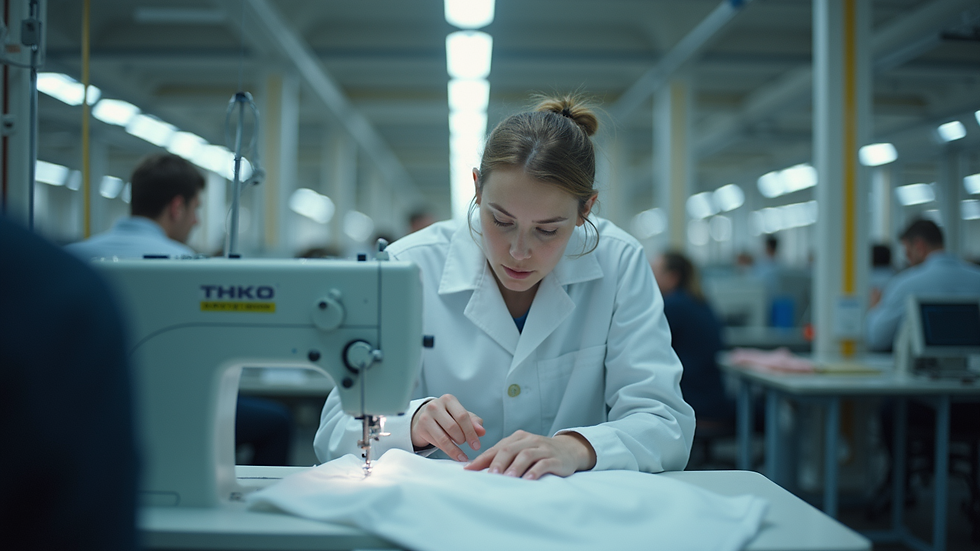Inside Our clothing production companies
- Darpan Thakar
- Jul 21
- 4 min read
Creating a piece of clothing involves much more than just sewing fabric together. It's a meticulous journey that combines skill, technology, and an artistic touch. Understanding the apparel production steps can help consumers appreciate the hard work and dedication that goes into every garment. In this blog post, we'll break down our clothing production process and provide insights into the stages of garment construction.
Apparel Production Steps in our Clothing production companies
At the heart of our apparel production steps lies a well-organized workflow designed to ensure quality from start to finish. The process begins with conceptual ideas and ends with a finished product ready for our customers. Each step is crucial, allowing us to maintain our standards while being efficient and innovative.
In our clothing production companies,Our clothing production process includes careful planning, sourcing materials, and applying the latest technology to craft apparel that meets both style and durability. Let’s dive deeper into each of these steps.

Sourcing Quality Materials
Every great garment starts with quality materials. The sourcing process involves selecting textiles that not only feel good but also stand the test of time.
When we choose fabrics, we consider several factors: texture, weight, durability, and sustainability. For example, cotton is soft and breathable, making it ideal for casual wear, while synthetic fabrics provide stretch and resilience, perfect for activewear. Additionally, we prioritize sustainable options by collaborating with eco-friendly suppliers. Choosing materials wisely is a foundation for the entire production process.

What are the 8 Stages in Garment Construction?
Understanding the stages in garment construction is key to knowing how to produce high-quality clothing. Here are the eight stages:
Design and Pattern Making: This stage involves sketching ideas and creating patterns, which serve as the blueprint for the garment.
Sample Creation: Next, a prototype or sample is made to assess design, fit, and aesthetics. This is critical for making any necessary adjustments.
Grading: Once the sample is finalized, the patterns are graded into different sizes to cater to a wide audience.
Fabric Cutting: The next step is cutting the textile into specified shapes using the patterns. Precision is vital in this step to ensure each piece fits perfectly.
Sewing: This stage involves assembling the cut pieces using industrial sewing machines. Skilled machinists follow the patterns meticulously to create the garment.
Finishing: After sewing, garments undergo finishing processes such as trimming threads, inserting zippers, and applying labels.
Quality Control: Before the clothing is packed, each piece is inspected for quality, checking for any defects that could affect the final product.
Packaging and Shipping: Finally, the garments are folded, packaged, and shipped to retailers or directly to customers.
Understanding these stages ensures that every garment produced meets our high standards in quality and fitting.

Technology in Apparel Production
The incorporation of technology into the apparel production process has revolutionized the industry. From automated cutting machines to advanced sewing equipment, technology speeds up production while maintaining quality.
Additionally, software tools can help in managing inventory, tracking orders, and forecasting trends. For instance, a computer-aided design (CAD) system allows designers to create and visualize their concepts before fabric selection. This integration of technology not only enhances efficiency but also reduces waste – a crucial aspect in today’s environmentally conscious market.
Sustainable Practices in Clothing Production
Sustainability is a growing concern in the fashion industry. As sustainable manufacturers, we are committed to minimizing our environmental impact during the clothing production process. This involves using eco-friendly materials, reducing waste, and ensuring ethical labor practices.
For example, we promote the use of organic fabrics and recycled materials when possible. Additionally, adopting a zero-waste philosophy in our cutting processes can significantly lower our overall consumption of textiles.
By taking these steps, we not only contribute positively to the environment but also appeal to a consumer market that prioritizes sustainable practices.
As we look to the future, the apparel production process continues to evolve. Innovations in technology, shifts in consumer behavior, and increasing regulations on sustainability are shaping the industry. Brands are now focusing more on transparency, helping consumers understand the journey of their clothing from design to delivery.
Moreover, direct-to-consumer models are gaining popularity, allowing brands to offer products at lower prices while engaging directly with their customers. As these trends continue, it’s crucial for manufacturers to adapt by investing in new technologies and sustainable practices that meet the changing demands of the market.
Understanding our clothing production process and the various steps in garment construction allows us to bring quality and style to every piece we create. By focusing on sustainable practices, leveraging technology, and forging strong relationships with suppliers, we can produce apparel that our customers can feel proud to wear.

By sharing our journey through these apparel production steps, we hope to foster appreciation and understanding for the art and science of garment making. As consumers continue to engage more with the fashion industry, knowledge of the production process empowers them to make informed choices, supporting ethical brands committed to quality and sustainability.









Comments